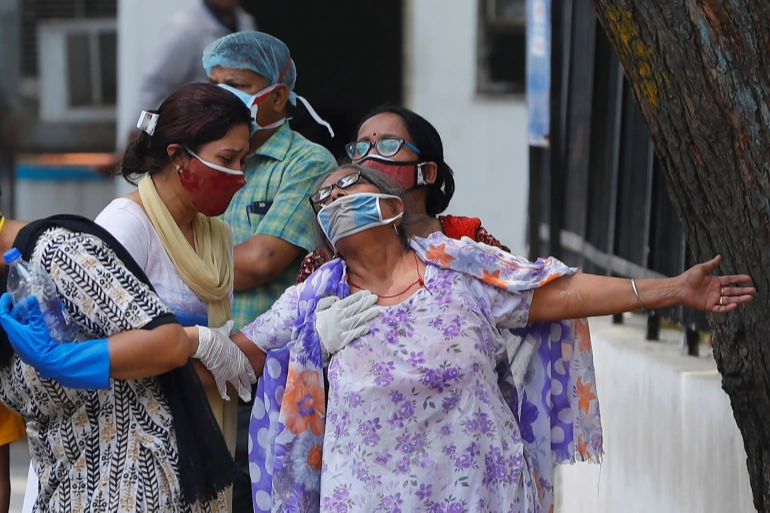
A woman mourns after seeing the body of her son who died due to COVID-19, outside a mortuary of a hospital in New Delhi [Adnan Abidi/Reuters]
New Delhi, May 13 (RHC)-- India has recorded more than 4,000 COVID-19 deaths for a second straight day, while infections stayed below 400,000 for a fourth day, as the virus rampages the rural areas where cases can go unreported due to a lack of testing.
According to the health ministry’s data on Thursday, India reported 362,727 new COVID-19 infections over the last 24 hours, with the total caseload now at 23.7 million. Deaths climbed by 4,120, taking the death toll to 258,317. Health experts believe the actual numbers could be five to 10 times higher.
The vicious second wave of the virus that erupted in February has left families weeping over the dead in rural hospitals or camp in wards to tend the sick, as hospitals remain inundated and medical staff overwhelmed.
Nearly 100 bodies washed up on the banks of the Ganges River, brought by relatives whose villages were stripped bare of the wood needed for cremations, stoking fears the virus was raging unseen in India’s vast rural hinterland where two-thirds of its people live. “Official statistics give you no idea of the devastating pandemic that is raging through rural Uttar Pradesh,” wrote activist and opposition politician Yogendra Yadav in The Print website.
“Widespread ignorance, lack of nearby or adequate testing facilities, official and unofficial cap on testing and inordinate delays in test reports have meant that in village after village, virtually no one has been tested, while scores of people complain of a ‘strange fever’.”
More than half the cases this week in the western state of Maharashtra were in rural areas, up from a third a month ago. That share is nearly two-thirds in the most populous, and mainly rural, state of Uttar Pradesh, government data showed.
A pregnant woman was taking care of her husband who had breathing difficulties in a hospital in Bhagalpur in the eastern state of Bihar, which is seeing a case surge its health system could barely have handled at the best of times. “There is no doctor here, she sleeps the whole night here, taking care of her husband,” the woman’s brother told India Today television.
In a corridor outside, two sons were wailing over the body of their father, saying repeatedly that he could have been saved if only he had been given a bed in an intensive care unit. At the general hospital in Bijnor, a town in northern Uttar Pradesh, a woman lay in a cot next to a garbage can and medical waste.
“How can someone get treated if the situation is like this?” asked her son, Sudesh Tyagi. “It is a hell out here.” Experts still cannot say for sure when numbers will peak and concern is growing about the contagiousness of the variant that is driving infections in India and spreading worldwide.
“We seem to be plateauing around 400,000 cases a day,” the Indian Express newspaper quoted virologist Shahid Jameel as saying. “It is still too early to say whether we have reached the peak.”
Bhramar Mukherjee, a professor of epidemiology at the University of Michigan, said most models had predicted a peak this week and that the country could be seeing signs of that trend. Still, the number of new cases each day is large enough to overwhelm hospitals, she said on Twitter. “The key word is cautious optimism.”

